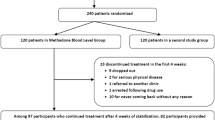Summary
Deuterated methadone (M-d3) and GC-MS analysis were used to study the steady state pharmacokinetics of methadone (M) in eight patients reported as therapeutic failures in a methadone maintenance treatment programme. The patients were compared to an unselected group of 12 patients stabilized on M for 25 days. During one dosage interval a pulse dose of M-d3 was administered intravenously instead of the oral M-dose (M-d0). The pharmacokinetic parameters, half-life in the β-phase (t1/2β), volume of distribution during the postdistributive phase (Vdβ) and during steady state (Vdss) were determined as well as the body (ClS) and renal (ClR) clearances of M. Pronounced differences in Vdβ and Vdss were found between the two groups. The therapeutic failures had a smaller Vdβ and Vdss 3.09±0.96 l/kg and 2.74±0.96 l/kg vs 4.56±1.00 l/kg and 4.20±0.78 l/kg in the control group. The differences were due to changes between the groups in the volume of the central compartment. Differences between the groups were also found in t1/2β — 24.5±2.6 h in the therapeutic failures and 34.0±7.0 h (p<0.001) in the comparison group. However, the change in t1/2β was probably a consequence of the change in Vdβ, as the body clearance of M was similar in the two groups — 104±36 ml/min vs 111±36 ml/min. The smaller volume of distribution could lead to unacceptably high fluctuation of M in the central compartment, and withdrawal symptoms during the latter part of the dosage interval. The appropriate treatment of this subgroup of patients on methadone treatment is not to increase the dose but to shorten the dosage interval. Alternatively, a longer-acting opiate, such as 1-α-acetylmethadol (LAAM), may be used.
Similar content being viewed by others
References
Gunne L-M, Grönbladh L (1981) The Swedish methadone maintenance program. A controlled study. Drug Alcohol Depend 7: 249–256
Horns WH, Rado M, Goldstein A (1973) Plasma levels and symptoms complaints in patients maintained on daily dosage of methadone hydrochloride. Clin Pharmacol Ther 17: 636–649
Holmstrand J, Änggård E, Gunne L-M (1978) Methadone maintenance: Plasma levels and therapeutic outcome. Clin Pharmacol Ther 23: 175–180
Nilsson M-I, Änggård E, Holmstrand J, Gunne L-M (1982) Pharmacokinetics of methadone in methadone maintenance treatment: Adaptive changes during the induction phase. Eur J Clin Pharmacol 22: 343–349
Sullivan HR, Marshall FJ, McMahon RE, Änggård E, Holmstrand J, Gunne L-M (1975) Massfragmentographic determination of unlabeled and deuterium labeled methadone in human plasma. Possibilities for measurements of steady state pharmacokinetics. Biomed Mass Spectrosc 2: 197–200
Author information
Authors and Affiliations
Rights and permissions
About this article
Cite this article
Nilsson, M.I., Grönbladh, L., Widerlöv, E. et al. Pharmacokinetics of methadone in methadone maintenance treatment: Characterization of therapeutic failures. Eur J Clin Pharmacol 25, 497–501 (1983). https://doi.org/10.1007/BF00542117
Received:
Accepted:
Issue Date:
DOI: https://doi.org/10.1007/BF00542117



